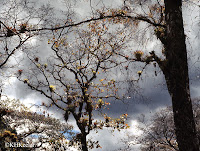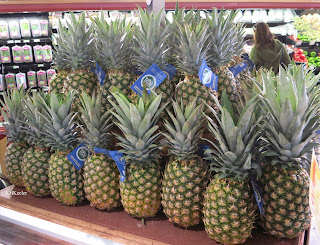 |
| pineapple plants |
The story of pineapples reminds us of a time when you couldn't zip around the globe in an airplane…
 |
| Lots of bromeliads in Costa Rican trees |
Pineapples were apparently domesticated prehistorically in South America and dispersed throughout all tropical America in very ancient times.
 The native people of Guadalupe, and other Caribbean islands, considered sharing pineapples a symbol of hospitality. When Columbus landed on Guadalupe on his second voyage in 1493, they offered him pineapples.
The native people of Guadalupe, and other Caribbean islands, considered sharing pineapples a symbol of hospitality. When Columbus landed on Guadalupe on his second voyage in 1493, they offered him pineapples.
Columbus and his men thought the pineapples were delicious. Columbus called them "pine of the Indies." The men in his crew and subsequent Spaniards called pineapples piña, from "pine" in Spanish. Apparently because it reminded all of them of a pine cone. The name piña or pine for pineapples carried over into English initially. In 1633, Gerard called it the pinia or pine thistle in his Herball. (It was not included in the first edition of the Herball in 1599, the one you can find online).
John Worledge is given credit for saying the fruit was "like a pineapple" in 1676. At that time, the word apple was used for any fruit, so a pine apple was the fruit of a pine tree, today called a pine cone. That name stuck, replacing pine of the Indies, pine thistle and older names. Despite the shared names, pineapples are obviously not much like either pines or apples.
John Worledge is given credit for saying the fruit was "like a pineapple" in 1676. At that time, the word apple was used for any fruit, so a pine apple was the fruit of a pine tree, today called a pine cone. That name stuck, replacing pine of the Indies, pine thistle and older names. Despite the shared names, pineapples are obviously not much like either pines or apples.
 During the 1500s, the Spanish, Portuguese and Dutch carried pineapples all over the tropics. The plant is relatively tolerant of drought and heat and can survive quite a while under adverse conditions. As a result it survived long sea voyages and was soon grown all over the tropical world.
During the 1500s, the Spanish, Portuguese and Dutch carried pineapples all over the tropics. The plant is relatively tolerant of drought and heat and can survive quite a while under adverse conditions. As a result it survived long sea voyages and was soon grown all over the tropical world.
From the time of Columbus, reports of how delicious pineapples were were brought back to Europe. Getting a pineapple fruit across the Atlantic without spoiling was another thing entirely. About 1570 one was brought to Holy Roman Emperor Charles V but it was rotten.
Attempts to grow pineapples in northern Europe were frustrated by its requirement for warm conditions and a long growing season. Pineapples grow very slowly under cool conditions and fruit development requires more time than a northern European summer provides. The gardeners of the 1500s and early 1600s knew what they needed to do to get pineapple fruit, they simply couldn't create those conditions. The development of glasshouses (hot houses, green houses) was driven by that knowledge. One of the first fruits grown in the earliest glasshouses was the pineapple.
In England, the first pineapple fruit successfully grown was during Cromwell's time, 1653-1658. In 1661 a greenhouse-grown pineapple was offered to Charles II, but the English king was not impressed. Although it was a great botanical success to have gotten the plant to flower and develop a fruit in the glasshouse, the fruit did not taste very good. (As we still observe of hot house fruits and vegetables.) A famous painting commemorated the presentation of the pineapple to King Charles. Interestingly, the existing painting is apparently an imitation of the original: John Rose (1619–1677), the Royal Gardener, presenting a Pineapple to King Charles II (1630–1685) (after Henry Dankerts), by Thomas Stewart (1766 - c. 1801): view painting .
In England, the first pineapple fruit successfully grown was during Cromwell's time, 1653-1658. In 1661 a greenhouse-grown pineapple was offered to Charles II, but the English king was not impressed. Although it was a great botanical success to have gotten the plant to flower and develop a fruit in the glasshouse, the fruit did not taste very good. (As we still observe of hot house fruits and vegetables.) A famous painting commemorated the presentation of the pineapple to King Charles. Interestingly, the existing painting is apparently an imitation of the original: John Rose (1619–1677), the Royal Gardener, presenting a Pineapple to King Charles II (1630–1685) (after Henry Dankerts), by Thomas Stewart (1766 - c. 1801): view painting .
The earliest mention of pineapple in an English cookbook is in Richard Bradley's second cookbook, published in 1732, which would suggest that by then they were not entirely a glasshouse novelty item. However although the book seems to be for a country housewife, he writes "To make a tart of the Ananas, or Pine-Apple. From Barbados." (see recipe (search on "pine-apples")).
My sources don't talk about it, but the availability of good pineapple outside of the tropics is a recent result of well-regulated refrigeration and air transport. In my childhood, the 1950s, pineapple came out of cans. Only canned pineapple was widely available. Fresh pineapples were rare, very expensive and almost always disappointing.
Refrigerated ships first made a successful trip in the 1870s, but unlike bananas, tomatoes and apples, pineapples do not ripen after picking but simply start to deteriorate. Even refrigerated, pineapples do not survive a long sea voyage (read about shipping pineapples). Bringing fruits grown in the tropics to markets in North America or Europe required temperature- and air-controlled containers on fast ships or planes.
Refrigerated ships first made a successful trip in the 1870s, but unlike bananas, tomatoes and apples, pineapples do not ripen after picking but simply start to deteriorate. Even refrigerated, pineapples do not survive a long sea voyage (read about shipping pineapples). Bringing fruits grown in the tropics to markets in North America or Europe required temperature- and air-controlled containers on fast ships or planes.
 |
| fresh pineapples in Colorado |
The pineapple story reminds us how far we have come in growing plants in greenhouses and in shipping fresh fruit across the world.
When you see fresh pineapple in your grocery store, think of the generations of kings in Europe who couldn't get one, no matter who they sent or what they spent.
Comments and corrections welcome.
Sources Consulted
Foster, Nelson and Linda S. Cordell. 1992. Chilies to Chocolate. Food the Americas gave the world. Tucson, AZ: University of Arizona Press.
Gerard, John. The Herbal or General history of plants. Complete 1633 edition as revised and enlarged by Thomas Johnson. Dover Publications, New York 1975.
Kiple, K.F. and K. C. Ornelas. 2000. The Cambridge World History of Food. London: Cambridge University Press.
Leal, F. 1997. Pineapple, Ananas comosus (Bromeliaceae), pp. 19-22 in J. Smartt and N. W. Simmonds. Evolution of Crop Plants. 2nd ed. London: Longman Scientific and Technical.
Oxford University Press. Oxford English Dictionary online. "apple," "pine apple" http://0-www.oed.com.library.unl.edu. Accessed May 9, 2011.
Simpson, Beryl B. and Molly C. Orgazaly. 2001. Economic Botany, Plants in Our World. Boston: McGraw-Hill.
Vaughan J. G. and C. Geissler. 1997. The New Oxford Book of Food Plants. Oxford: Oxford University Press.
Buy the Book! Give it as a gift! This story and thirteen other plants from around the world are told in Curious Stories of Familiar Plants from Around the World. Available on Amazon link.
http://awanderingbotanist.com

Thank you, I am just learning about bromeliads.
ReplyDelete